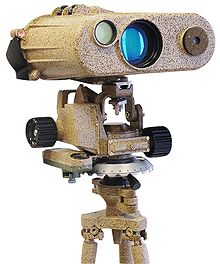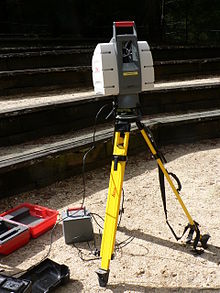Laser rangefinder: Difference between revisions
This image ought to expand visual understanding for the use of rangefinders. Taylor is a leading champion tree discoverer. |
m Moved image upward |
||
| Line 15: | Line 15: | ||
Some of the laser light might reflect off leaves or branches which are closer than the object, giving an early return and a reading which is too low. Alternatively, over distances longer than 1200 ft (365 m), the target, if in proximity to the earth, may simply vanish into a [[mirage]], caused by temperature [[gradients]] in the air in proximity to the heated desert bending the laser light. All these effects have to be taken into account. |
Some of the laser light might reflect off leaves or branches which are closer than the object, giving an early return and a reading which is too low. Alternatively, over distances longer than 1200 ft (365 m), the target, if in proximity to the earth, may simply vanish into a [[mirage]], caused by temperature [[gradients]] in the air in proximity to the heated desert bending the laser light. All these effects have to be taken into account. |
||
| ⚫ | |||
----the calculation---- |
----the calculation---- |
||
D=ct/2 |
D=ct/2 |
||
| Line 39: | Line 40: | ||
=== Discrimination === |
=== Discrimination === |
||
| ⚫ | |||
Some instruments are able to determine multiple returns, as above. These instruments use [[waveform]]-resolving detectors, which means they detect the amount of light returned over a certain time, usually very short. The waveform from a laser pulse that hits a tree and then the ground would have two peaks. The first [[peak-to-peak|peak]] would be the distance to the tree, and the second would be the distance to the ground. |
Some instruments are able to determine multiple returns, as above. These instruments use [[waveform]]-resolving detectors, which means they detect the amount of light returned over a certain time, usually very short. The waveform from a laser pulse that hits a tree and then the ground would have two peaks. The first [[peak-to-peak|peak]] would be the distance to the tree, and the second would be the distance to the ground. |
||
Revision as of 19:07, 15 March 2009
A laser rangefinder is a device which uses a laser beam in order to determine the distance to a reflective object. The most common form of laser rangefinder operates on the time of flight principle by sending a laser pulse in a narrow beam towards the object and measuring the time taken by the pulse to be reflected off the target and returned to the sender. Due to the high speed of light, this technique is not appropriate for high precision sub-millimeter measurements, where triangulation and other techniques are often used.

Operation
Pulse
The pulse may be coded in order to reduce the chance that the rangefinder can be jammed. It is possible to use Doppler effect techniques to judge whether the object is moving towards or away from the rangefinder, and if so how fast.
The accuracy of the instrument is determined by the brevity of the laser pulse and the speed of the receiver. One that uses very short, sharp laser pulses and has a very fast detector can range an object to within a few centimeters.
Range
Despite the beam being narrow, it eventually spreads over long distances due to the divergence of the laser beam, as well as to scintillation and beam wander effects, caused by the presence of air bubbles in the air acting as lenses ranging in size from microscopic to roughly half the height of the laser beam's path above the earth.
These atmospheric distortions coupled with the divergence of the laser itself and with transverse winds that serve to push the atmospheric heat bubbles laterally may combine to make it difficult to get an accurate reading of the distance of an object, say, beneath some trees or behind bushes, or even over long distances of more than 1 km in open and unobscured desert terrain.
Some of the laser light might reflect off leaves or branches which are closer than the object, giving an early return and a reading which is too low. Alternatively, over distances longer than 1200 ft (365 m), the target, if in proximity to the earth, may simply vanish into a mirage, caused by temperature gradients in the air in proximity to the heated desert bending the laser light. All these effects have to be taken into account.

the calculation----
D=ct/2
D=the distance between point A and point B c=the constant of light speed in atmosphere t=the period a light round trip between point A and point B
t=φ/ω
ω=angular frequency of optical modulation φ=the delay which made by the light traveling
then, substitue the values in the equation D=ct/2,D=1/2 ct=1/2 c·φ/ω=c/(4πf) (Nπ+Δφ)=c/4f (N+ΔN)=U(N+)
in this equation, U stands for the unit length.
Δφ stands for the delay part which does not fulfill π.
ΔN stands the decimal value.
ΔN=φ/ω
Discrimination
Some instruments are able to determine multiple returns, as above. These instruments use waveform-resolving detectors, which means they detect the amount of light returned over a certain time, usually very short. The waveform from a laser pulse that hits a tree and then the ground would have two peaks. The first peak would be the distance to the tree, and the second would be the distance to the ground.
The ability for aircraft-mounted instruments to see "through" dense canopies and other semi-reflective surface such as the ocean provide many applications for airborne instruments such as:
- Creating "bare earth" topographic maps - removing all trees
- Creating vegetation thickness maps
- Bathymetry (measuring topography under the ocean)
- Forest fire hazard
- Overwash threat in barrier islands
Technologies
Time of flight - this measures the time taken for a light pulse to travel to the target and back. With the speed of light known, and an accurate measurement of the time taken, the distance can be calculated. Many pulses are fired sequentially and the average response is most commonly used. This technique requires very accurate sub-nanosecond timing circuitry.
Multiple frequency phase-shift - this measures the phase shift of multiple frequencies on reflection then solves some simultaneous equations to give a final measure.
Interferometry - the most accurate and most useful technique for measuring changes in distance rather than absolute distances.
Applications
Military

Rangefinders provide an exact distance to targets located beyond the distance of point-blank shooting to snipers and artillery. They can also be used for military reconciliation and engineering.
Handheld military rangefinders operate at ranges of 2 km up to 25 km and are combined with binoculars or monoculars. When the rangefinder is equipped with a compass and inclinometer it is capable of providing magnetic azimuth, inclination, and height (length) of targets. Some rangefinders can also measure a target's speed in relation to the observer. Some rangefinders have cable or wireless interfaces to enable them to transfer their measurement(s) data to other equipment like fire control computers. Some models also offer the possibility to use add-on night vision modules. Handheld rangefinders use standard or non-magnetic batteries.[1]
The more powerful models of rangefinders measure distance up to 25 km and are normally installed either on a tripod or directly on a vehicle or gun platform. In the latter case rangefinder module is integrated with on-board thermal, night vision and daytime observation equipment. The most advanced military rangefinders can be integrated with computer.
In order to make laser rangefinders and laser-guided weapons less useful against military targets, various military arms may have developed laser-absorbing paint for their vehicles. Regardless, some objects don't reflect laser light very well and using a laser rangefinder on them is difficult.
3-D Modelling

Laser rangefinders are used extensively in 3-D object recognition, 3-D object modelling, and a wide variety of computer vision-related fields. This technology constitutes the heart of the so-called time-of-flight 3D scanners. In contrast to the military instruments described above, laser rangefinders offer high-precision scanning abilities, with either single-face or 360-degree scanning modes.
A number of algorithms have been developed to merge the range data retrieved from multiple angles of a single object in order to produce complete 3-D models with as little error as possible. One of the advantages that laser rangefinders offer over other methods of computer vision is that the computer does not need to correlate features from two images to determine depth information as in stereoscopic methods.
The laser rangefinders used in computer vision applications often have depth resolutions of tenths of millimeters or less. This can be achieved by using triangulation or refraction measurement techniques as opposed to the time of flight techniques used in LIDAR.
Handheld distance meters
Opti-Logic Corporation introduced the first consumer level time of flight handheld laser distance meter in 1987. The original handheld consumer priced laser rangefinders were used for golf. Since that time numerous applications have developed. The most popular use is for hunting.
Until 1993, phase shift instruments were reserved to professional users giving their prices and rich functions like bluetooth measurements transmission. Less expensive models around 150$/€ are emerging from Bosch with the DLE 50 or Stanley Works with the TLM 100.
Sports
Laser rangefinders may be effectively used in various sports that require precision distance measurement, such as golfing, hunting, archery, sniper shooting. Several manufacturers, such as Opti-logic Corporation, Bushnell, Leica, Nikon and Swarovski supply handheld rangefinders at prices well in line with the rest of sports equipment.
Handheld rangefinders are marked in terms of distance they measure to a reflective target, called rated distance. As a rule of thumb, rated distance should be divided by three to estimate actual average distance to a shooting target or golf pin. Practically speaking, a rangefinder marked as XYZ-1000 will give consistent measurements up to 400 m.
Industry production processes
An important application is the use of laser Range finder technology during the automation of stock management systems and production processes in steel industry.
